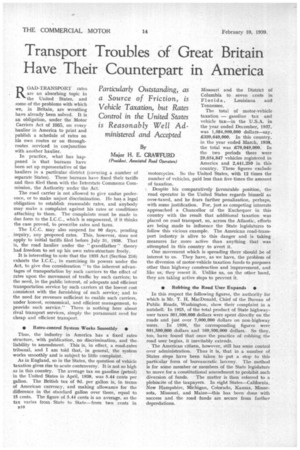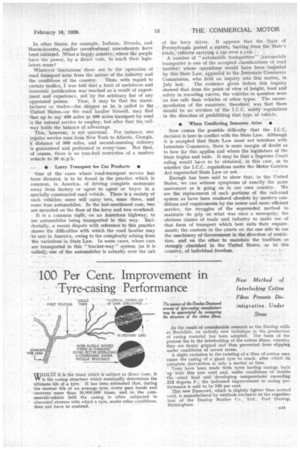Transport Troubles of Great Britain Have Their Counterpart in America
Page 44

Page 45

If you've noticed an error in this article please click here to report it so we can fix it.
ROAD-TRANSPORT rates are an absorbing topic in the United States, and some of the problems with which we, in Britain, are wrestling have already been solved. It is an obligation, under the Motor Carriers Act of 1935, on every haulier in America to print and publish a schedule of rates on his own routes routes serviced with another ha
In practice, pened is that been set up representative of the or on throughin conjunction Wier.
what has hapbureaus have hauliers in a particular district (covering a number of separate States). These bureaus have fixed their tariffs and then filed them with the Interstate Commerce Commission, the Authority under the Act.
The road carrier is not allowed to give undue preference, or to make unjust discrimination. He has a legal obligation to establish reasonable rates, and anybody may make a complaint against his rates or conditions attaching to them. The complaints must be made in due form to the I.C.C., which is empowered, if it thinks the case proved, to prescribe rates and fares.
The I.C.C. may also suspend for 90 days, pending inquiry, any proposed rates. This, however, does not apply to initial tariffs filed before July 31, 1938. That is, the road haulier under the " grandfather " theory had freedom to set up his own rates-structure freely.
It is interesting to note that the 1935 Act (Section 216) exhorts the I.C.C., in exercising its powers under the Act, to give due consideration " to the inherent advantages of transportation by such carriers to the effect of rates upon the movement of traffic by such carriers; to the need, in the public interest, of adequate and efficient transportation service by such carriers at the lowest cost consistent with the furnishing of such service; and to the need for revenues sufficient to enable such carriers, under honest, economical, and efficient management, to provide such service." There is nothing here about rival transport services, simply the paramount need for cheap and efficient transport.
fo Rates-control System Works Smoothly •
Thus, the industry in America has a fixed rates structure, with publication, no discrimination, and the liability to amendment. This is, in effect, a road-rates tribunal, and I am told that, in general, the system works smoothly and is subject to little complaint.
As in England, so in the States, the question of vehicle taxation gives rise to acute controversy. It is not so high as in this country. The average tax on gasoline (petrol) in the United States in April, 1938, was 5.44 cents per gallon. The British tax of 9d. per gallon is, in terms of American currency, and making allowance for the difference in the standard gallon over there, equal to 15 cents. The figure of 5.44 cents is an average, as the tax varies from State to State—from two cents in 1310 Missouri and the District of Columbia to seven cents in Florida, Louisiana and Tennessee, The total of motor-vehicle taxation — gasoline tax and vehicle tax—in the U.S.A. in the year ended December, 1937, was 1,584,990,000 dollars say, £339,640,000. In this country, in the year ended March, 1938, the total was £79,049,000. In the two periods there were 29,654,847 vehicles registered in America min 2,441,250 in this country. These figures exclude motorcycles. So the United States, with 12 times the number of vehicles, paid less than five times the amount of taxation.
Despite his comparatively favourable position, the road operator in the United States regards himself as over-taxed, and he fears further penalization, perhaps, with some justification. For, just as competing interests approached a Chancellor of the Exchequer in this country with the result that additional taxation was placed on road transport, so, across the Atlantic, efforts are being made to influence the State legislatures to follow this vicious example. The American road-transport industry is alive to this danger and is taking measures far more active than anything that was attempted in this country to avert it.
One movement which is spreading there should be of interest to us. They have, as we have, the problem of the diversion of motor-vehicle taxation funds to purposes other than highway construction and improvement, and like us, they resent it Unlike us, on the other hand, they are taking active steps to prevent it.
• Robbing the Road User Expands • In this respect the following figures, the authority for which is Mr. T. H. MacDonald, Chief of the Bureau of Public Roads, Washington, show their complaint in a nutshell. In 1925, of the total product of State highwayuser taxes 361,500,000 dollars were spent directly on the roads and just over 7,000,000 dollars on non-highway users. In 1936, the corresponding figures were 691,500,000 dollars and 169,500,000 dollars. So they, ,too, have found that once the practice of robbing the road user begins, it inevitably extends.
The American citizen, however, still has some control over administration. Thus it is, that in a number of States steps have been taken to put a stop to this particular form of bureaucratic larceny. The method is for some member or members of the State legislature to move for a constitutional amendment to prohibit such diversion of funds. The matter is then referred to a plebiscite of the taxpayers. In eight States—California, New Hampshire, Michigan, Colorado, Kansas, Minnesota, Missouri, and Maine—this has been done with success and the road funds are secure from further depredations.
In other States, for example, Indiana, Nevada, and Massac.husetts, similar constitutional amendments have been initiated. What a hapPy country, where tie people have the power, by a direct vote, to teach their legislators sense!
Whatever limitations' there are to the operation: of road transport arisefrom the nature of the industry and the conditions of the country. Thus, with regard to certain traffics, I was told that a limit of usefulness and economic justification was:reached as a result of experiment' and experience, not by the arbitrary fiat of any appointed person. Thus, it may be that the manufacturer or trader—the shipper as he is called in the United States—or the road haulier himself, may find that up to say 400 miles or 500 miles transport by road is the natural service to employ, but after that the railway holds the balance of advantage.
This however, is riot universal. For instance, one • regular service runs 'from New York to Atlanta, Georgia, b. distance of 900 miles, and second-morning delivery is guaranteed and performed in every"case. But then, of course, there is no tom-fool restriction of a modern vehicle to 20 m.p.h.
• Lorry Transport for Car Products •
' One of the cases where road-transport service has been dictated, is to be found in the practice which is common, in America, of driving complete motorcars away from factory or agent -to agent or buyer in a specially constructed road vehicle. There is a variety of such vehicles; some will carry two, some three, and some four automobiles. In the last-mentioned case, two are mounted on the floor of the lorry and two overhead.
It is a common siglit, on an American highway, to see automobiles being :transported in this way. Incidentally, a recent dispute with reference to this practice shows the difficulties with which the road haulier may :'be met in America, owing to the complexity arising from the variations in State Law. In some cases, where cars are transported in this " trucker-way" system (as it is tailed), one of the automobiles is actually over the cab of the lorry driver. It appears that the :State of Pennsylvania liaised a statute, barring from the 'State's roads, vehicles carrying a ear over a .ca.b. •
A number of "automobile transporters" (automobile transporter is one of the accepted classifications of: road haulier) whose operations would have been .imPerled by this State Law, appealed to 'the Interstate 'Commerce Commission, who held an inquiry into this matter, in July last. The evidence given before this inquiry showed that from the point of view of height, load and safety in rounding curves, the vehiclea in question were no less safe than vehicles of other types. The recommendation of the examiner, therefore, was that there should be no revision of the' I.C.C. safety 'regulations in the direction of prohibiting that type of vehicle.
• 'When Conflicting Interests Arise •
Now comes the possible difficulty that the I.C.C. decision is here in conflict with the State Law. Although it is accepted that State Law must not interfere with Interstate Commerce, there is some margin of doubt as to how far this applies and where the legislature of the State begins and ends. It may be that a Supreme Court ruling would have to be obtained, in this case, as to whether the I.C.C. regulations under the Motor Carriers Act superseded State Law or not: Enough has been said to show that, in the United States, we can witness symptoms of exactly the same movement as is going on in our own country. We see the replacement of such portions of the rail-road system as have been rendered obsolete by modern conditions and requirements by the newer and more efficient service; the struggles of the superseded method to maintain its grip on what was once a monopoly; the obvious claims of. trade and industry to make use of that form of transport which best suits their requirements; the contests in the courts on the one side to use the machinery of Government in the direction of restriction, and on the other to maintain the tradition. .as strongly cherished in the United States, : as in this country, of individual freedom. :




























































































